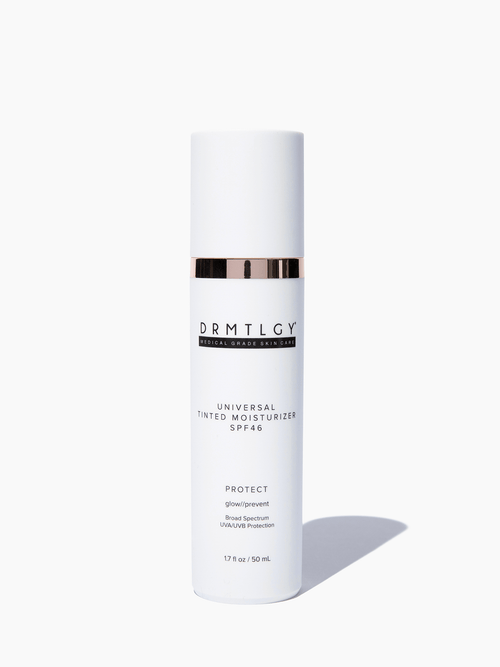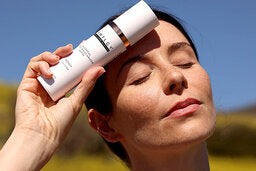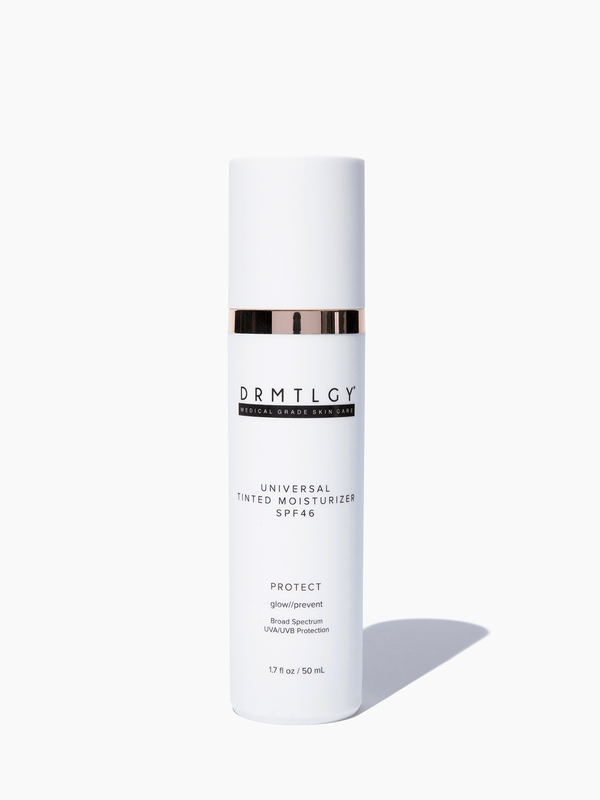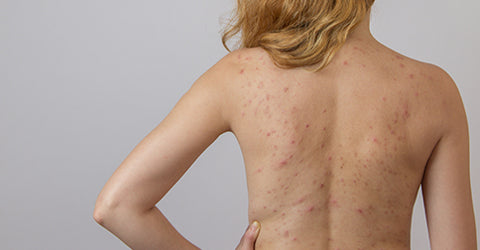
As anyone who’s ever had body acne knows, it’s the bane of summer wardrobes. It can be hard to muster up the courage to bare your shoulders or wear scoop neck tops when it feels like everyone will be staring at your pimples instead.
But, it’s a good thing you’re reading this now. Any esthetician will tell you that it takes about six months and a great skincare regimen to fade your acne scars. Keep reading to learn how to get rid of body acne and get glowing skin -- right on time for that sweet summer vacation you’ve been dreaming about.
What is Body Acne?
Acne forms when your pores get blocked with oil, dirt, and dead skin cells. That means that, because pores are found all over your body, acne can too. Body acne isn’t limited to just your chest, back, or shoulders either; they can also appear on your legs, torso, and other areas.
Just as factors like oily skin, hormones, and dehydration can drive breakouts on your face, addressing the cause of the blemishes on your body will be key to banishing them.
How is Chest and Back Acne Different from the Acne on Your Face?
In addition to all of the things that can trigger facial acne, a few more factors come into play when it comes to treating body acne. The skin on your body comes into contact with many more things than the skin on your face does, so the potential for breakouts increases exponentially.
For starters, your body is much more likely to get acne mechanica. It’s when your skin breaks out after being pressed or rubbed against heavy clothing or gear for extended periods of time. When this happens, sweat and dirt gets trapped in the pores and blocks them. This kind of breakout can often be found in soldiers, students, and athletes.
Sometimes the breakouts on your body can be attributed to folliculitis instead, which is when the hair follicle gets infected by bacteria or yeast. The pore then swells up and can fill up with pus, making them look similar to acne.
To treat body acne, you’ll want to make sure to use products that are formulated specifically for your body. Body acne can be harder to get rid of than facial acne, so products with higher concentrations of actives will make a huge difference. But don’t worry: your body skin is also much tougher than the skin on your face, so it can handle more intense formulations.
Make sure to avoid picking at these breakouts too, because the skin on your chest and back scar very easily and heal slowly. Acne scarring can be a challenge to treat and can often get worse over time; ideally this is one battle you want to avoid altogether.
Thankfully, because body acne is still acne at the end of the day, they can be treated in much the same way as a breakout on your face. Here’s how.
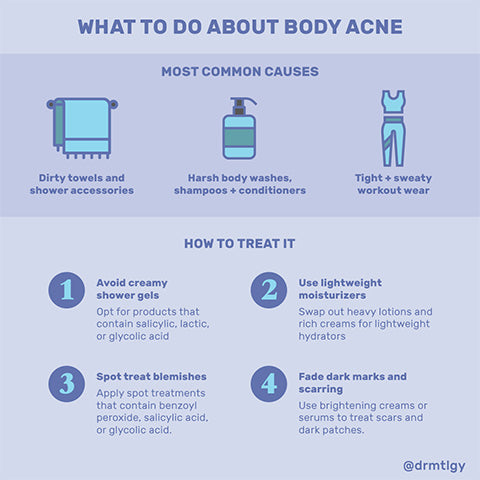
7 Tips to Get Rid of Body Acne
Shower every day and right after your workout.
Yes, every day. Even if it’s cold and dry. Even if you think you didn’t sweat that much. (Also, yes, a body shower works if you don’t want to wash your hair every day.)
When you work out or spend a day out in the summer, shower immediately when you get back. Sweat and oil build up quickly and bacteria flourish in the warm, moist environment created by your skin and clothes. If you can’t shower right away, bring a pack of cleansing wipes to wipe down your body, focusing on the areas that are most prone to breakouts.
You may also want to consider bringing a clean towel with you to the gym to limit the spread of bacteria. If possible, wipe down the workout equipment before and after you use it too.
Change your body wash.
Ditch your scented body wash for one that contains a mild exfoliating ingredient like salicylic acid. Avoid products containing benzoyl peroxide, though. Although this chemical is very effective in combating acne, it can stain fabrics like your clothes or sheets if you’re not careful.
Avoid soaps containing perfumes or fragrances because they can irritate your skin -- not ideal when you’re trying to get rid of a back breakout.
Exfoliate, exfoliate, exfoliate.
Skin cells naturally shed themselves in the cell turnover process, but sometimes they need some assistance. By exfoliating your skin, you can speed this process up yourself and reduce the chances of dead skin cells blocking your pores.
Exfoliate acne-prone areas once a week with a physical exfoliator like a scrub, or a chemical one if your skin is sensitive. However, don’t overdo it or you may further aggravate your skin instead.
Choose non-comedogenic skincare products.
Your skincare products stay on your skin all day, so choosing non-comedogenic options that don’t clog pores will do a lot to reduce body acne.
Moisturizers have been proven to improve the look of acne both directly and indirectly. It keeps moisture in and reduces water evaporation from the surface of the skin; this prevents overproduction of oil and lowers the chance of breakouts. Using them alongside a prescription treatment can also boost the skin’s tolerance to the product.
Look for one with ingredients like ceramides or cholesterol, or salicylic acid if you prefer some light exfoliating action.
When it comes to sunscreen, go for a lightweight, non-comedogenic formula with zinc in it. Sunscreens that contain zinc oxide are usually less irritating to the skin than other formulas.
Wear loose clothing made from natural fibers.
Avoid itchy fabric that can irritate your skin and tight clothing made from synthetic fabrics that can trap bacteria. To reduce the amount of friction your skin experiences, limit the amount of time you wear accessories like backpacks, shoulder bags, caps, and clothes with tight collars.
Instead, choose loose-fitting pieces made with natural fibers like cotton. Wear sweat-wicking clothes during your workouts or on hot days.
Wash your sheets and towels regularly.
Remember when we said that your body comes into contact with more surfaces than your face does? Things like your clothes, bedsheets, and towels all harbor acne-causing bacteria so it doesn’t matter how diligently you wash your hands; if you don’t take care of these other things too, you can still transfer the bacteria back onto your face.
Wash them all once a week, if possible. Because fragrances can irritate your skin, choose a hypoallergenic laundry detergent that doesn’t contain them. Go easy on the dryer sheets and softeners too, as they also contain irritants that can exacerbate your current breakouts.
In the same vein, you’ll also want to give your phone, laptop, mouse, and other surfaces you touch regularly a thorough wipedown every week as well.
Visit a board-certified dermatologist.
Acne products can take up to three months before you start to notice its effects, so don’t frantically schedule an appointment three days into your new regimen. It can be frustrating to not see any changes take place immediately, but consistency and patience is important when adding new products to your routine.
If nothing changes after the three month mark, bring it up to your dermatologist. They can offer you some pointers on how best to address your situation, or prescribe stronger treatments that you wouldn’t be able to get over-the-counter.
And if what you’re experiencing isn’t even acne at all but an acne look-alike, they have the expertise to diagnose it and advise you on the best treatment.
Acne is normal (yes, even body acne), and it’s nothing to be ashamed of. One study revealed that up to 80% of people between 11-30 years of age have experienced it, as well as up to 5% of people older than 30.
That means that almost everyone has experienced acne at some point in their lives, so you shouldn’t feel any less for having it. With that being said, you can certainly take steps in looking and becoming your absolute best -- and we’re here to help you every step of the way.
For assistance in building the best skincare routine to treat body acne, talk to one of our skincare experts today!
References
Journal of Drugs in Dermatology, November-December 2006, Volume 5, Issue 10, pages 985-990
The Journal of Clinical and Aesthetic Dermatology, August 2015, Volume 8, Issue 8, pages S2-S8
Journal of the American Academy of Dermatology, July 2001, Volume 45, Issue 1, pages 109-117

